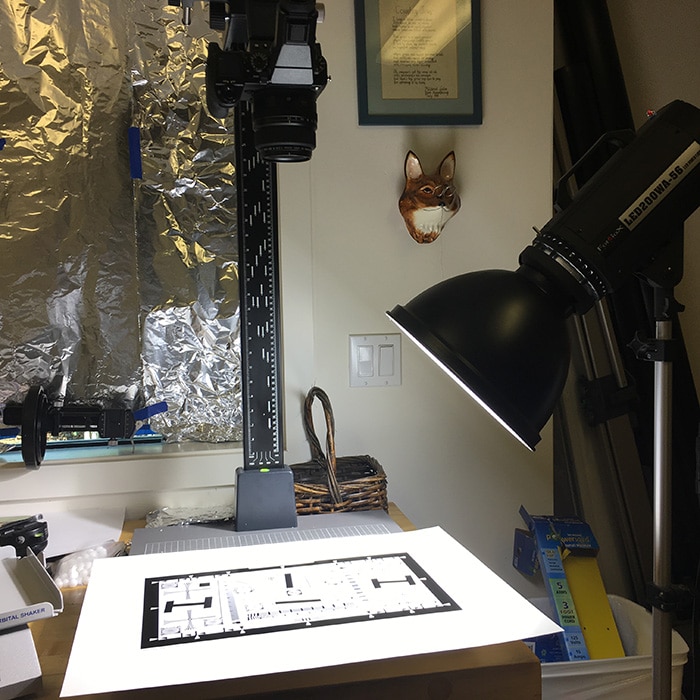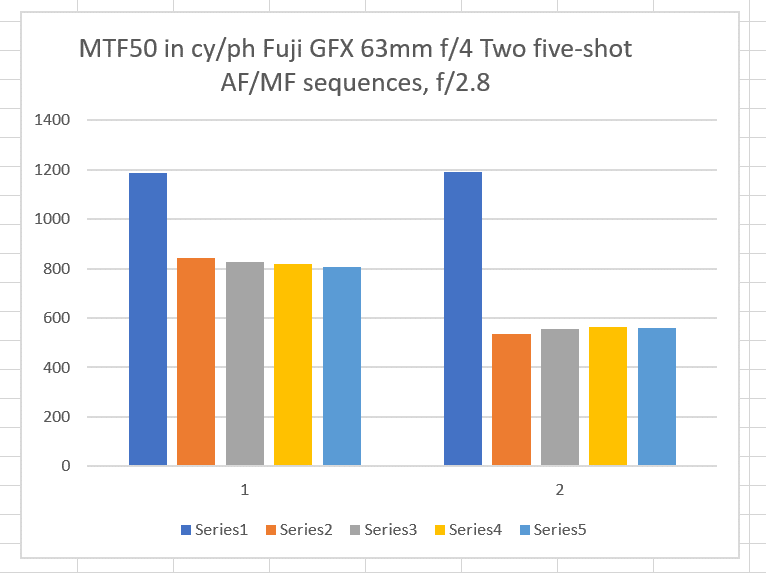This is the 73rd in a series of posts on the Fujifilm GFX-50S. The series starts here.
Someone asked me to do a test of focus shift with the Fuji 63 mm f/2.8 lens on the GFX 50S with the camera in a vertical position, so that gravity was having the greatest possible effect on the focusing mechanism. He was interested in having the focus first acquired automatically. So I set up the following test.
- Aim the camera down 90 degrees.
- Use one of the slanted edge targets on the (old version of the) ISO 12233 chart
- Set shutter speed to A
- Set aperture manually to f/2.8.
- Set AF mode to S
- Set drive to single
- Turn on 2-second shutter delay
- Press the shutter release
- Set AF mode to M to freeze focal position
- Shoot another 4 shots 60 seconds apart
- Convert RAF to cropped TIFF with Lr in default settings except for Daylight WB and exposure tweak.
- Compute sharpness shots using Imatest in cycles per picture height
- Repeat once.
The setup:
The results:
The dark blue columns are the AF exposures that start each of the two sequences. The rest of the columns are the rest of the sequence, made after the focusing mode is changed to manual.
The drift of the manual exposures is low. It looks like the first sequence is drifting in the out of focus direction and the second one is drifting into focus, but those changes are very small.
But here’s the shocker: changing the focus mode from AF to MF does not lock in the AF setting, but some other setting. This is not good news for me, as I use that trick with other cameras, where it works well.


Hi Jim,
Thank you very much for all test you are publishing. It is very useful.
Could you help me with the choise. I am planning to buy GFX with one of the primes. I read that your opinion about 63 mm is not as good as with others. It’s it the same for 45 mm? I am considering one of those two because size is a matter for me.
Thanks, Azamat
Hello Jim,
Thanks for your fantastic in-depth articles.
I currently use the GFX50s + 23, 45, 63, 120 & the 32-64 on a daily basis for architectural imaging.
I have experienced, on a number of occasions, a marked focus shift when switching to MF after autofocusing.
My current technique, after the shot is set up, is to:
1. Select working aperture.
2. AF. (my eyesight is less than 20/20)
3. Switch to MF.
4. Capture images using bracketed shutter speed ( 2sec delay).
The camera is alway tripod mounted.
Is it user error?
I never had this problem using my Canon 5Ds4.
Any advice would be great appreciated as my work flow is now slower (Im now checking the previews @max magnification after each bracket) due to the fact that I don’t fully trust that there was no shift when MF is selected.
Cheers,
Craig.
If it happens about one time in 40 or 50, it’s about like mine. But I don’t understand why you don’t let the camera focus for every shot, since you’re using autofocus in the first place.
Jim
I need absolutely repeatable images for layering & Ive found that when using AF for all images in the sequence, occasionally there are some that don’t register.
Maybe a visit to the Fuji doctor is needed?
(Ill use your stopped down MF technique until then).
Another quick question: Do you advocate EFC for shutter speeds below 1/125/sec?
Cheers
Craig
I do.